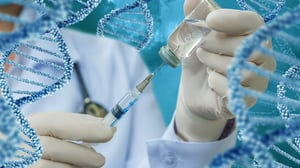An Indian pharmaceutical company has been given the go-ahead to market a very different vaccine from those used so far, which may pave the way for an entirely new category of medicines.
The ZyCoV-D Covid vaccine has just been approved by Indian health authorities for people over the age of 12. This is a vaccine unlike any other because, for the first time in the world, it uses a fragment of DNA, and not messenger RNA (like those of Pfizer and Moderna) to encourage our cells to produce the coronavirus spike protein and alert our immune system, preparing it to encounter the 'real' virus.
This technique, like that of RNA vaccines, has been studied since the 1990s, but it had not been used on a large scale in humans and had not obtained the green light from authorities, because it did not produce the desired results until 2020. However, with the onset of the pandemic and the enormous amount of funds made available by European and American institutions, there came a breakthrough in research.
How do DNA and RNA work?
So what is so innovative about DNA vaccines compared to messenger RNA vaccines? RNA is a DNA molecule that implements instructions in the genetic code - it transforms the genetic information in DNA into proteins. DNA is, to all intents and purposes, 'the code' itself and is located in the nucleus of cells, while RNA, after a brief period inside the nucleus, moves into the cytoplasm (the remaining liquid, part of the cell). The need to get the DNA fragment into the nucleus made creating this kind of vaccine particularly complicated from a technical standpoint. Despite there still being no shortage of problems, it is relatively ‘easier’ to enable RNA to gain access to cytoplasm.
Researchers at Zydus Cadila, the Indian company that manufactured ZyCoV-D, achieved this important result by targeting the cells of the immune system located just below the outer layer of the skin. These cells are extremely reactive and ready to incorporate any foreign body into their nucleus. In order for the vaccine to be captured and 'consumed' by these particular immune system cells, and for the DNA fragment to enter their nucleus, ZyCoV-D is administered differently from other vaccines. It is a subcutaneous (or transdermal, to use the technical term) administration instead of an injection into the muscles of the arm. As explained in the scientific journal Nature, the vaccine is administered using a needle-free device pressed against the skin, which pierces it painlessly and creates a fine, high-pressure flow of fluid.
A more robust vaccine than its competitors
After initially promising tests in the laboratory and on animals (DNA vaccines have long been used in veterinary medicine, especially for other diseases in horses) Indian researchers tested the new Covid vaccine on humans. The results obtained, are not particularly positive yet but are, nevertheless, encouraging and pave the way, as described in Nature, for the application of this technique in other areas as well as Covid.
ZyCoV-D is administered in three doses. It is easy to produce and store, as it remains stable at much higher temperatures than RNA vaccines (which have to be kept in freezers), making it especially suitable for countries that do not always have access to refrigeration.
In terms of effectiveness, results among 28,000 people report 21 cases of Covid among those vaccinated, and 60 among those who received a placebo. This means that the vaccine offers 67% protection against symptomatic forms of the disease. This is far-removed from the coverage offered by RNA vaccines, but fairly comparable to that of viral vector vaccines, like Johnson & Johnson and AstraZeneca.
Some observers think that the approval process has been too fast, with approval even before the publication of the final trial data. However, the company and the Indian health authorities replied that the data exists and will be published soon. Given the situation in India, which still has an extremely high number of infections, the authorities decided to increase the availability of vaccines without further delay.
Added DNA does not enter chromosomes
So is it risky to insert a new piece of DNA into the nucleus of our cells to 'force' them to synthesise the spike protein? Absolutely not, say researchers, because the DNA is introduced into the cells by the vaccine in the form of circular strands called plasmids, which are immediately converted into RNA and transfer into the cytoplasm. This RNA then produces the spike protein, which in turn stimulates the immune system. “Plasmids, Nature writes, typically degrade within weeks to months, but the immunity remains”.
There is also a further consideration: the laws of biology dictate that plasmids introduced into the body to enter our chromosomes via the vaccine, cannot modify our 'principal' DNA. Plasmids are well understood, as they have been used for years in many other areas of research (as 'vectors' for various substances). They have their own pathway that is completely independent of that of our principal DNA.
We might add that the impossibility of integration into actual DNA, will however need to be explained very clearly, with a great deal of documentation, to the non-expert public at large when these vaccines arrive in Europe, to avoid misunderstandings about a sensitive subject like that of our genetic code.

